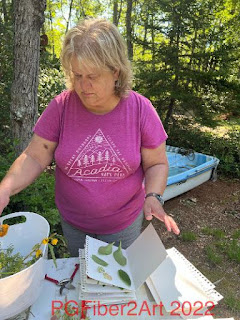Last time Elizabeth shared eco printing on paper with her sister Becky in New Hampshire. Meanwhile, in Virginia, Sue was also experimenting with botanical printing. Her first attempt was using rose petals to dye fabric. Fading anniversary flowers were the impetus for this effort which turned out reasonably well.
The fabric was first soaked in a mordant containing alum and washing soda to help the color bond to the fabric. It was also spritzed with diluted vinegar. The flower petals were sprinkled on half the fabric, then it was folded in half before rolling and tying
Iron, in the form of rusty keys, was also added to the pot. The bundled fabric was steamed for about 2 hours, then allowed to sit over night before unwrapping.
Then the flower petals were scraped off and the color was heat set with an iron after the fabric was dry.
Sue then decided to try some eco dyeing with other plant materials. This time she used both fabric and watercolor paper. The results from this experiment were less than stellar (not enough tannins in the leaves?) so she did a second round with the same fabrics and papers. The following pictures are after 2 rounds of dyeing.
Fabrics and paper were steamed together, again with rusty bits in the water for iron. The best paper print is the one above. Below are all 6 of the paper prints.
As you can see the prints are not very distinct, but these could potentially be used for overprinting by several methods. Top on the list to try is cyanotype printing. Likewise, the fabrics do not have distinct prints, just the typical eco-print coloration which I think could make interesting backgrounds for something else.
Bottom line, the eco printing requires a bit more reading/research and experimentation to find the combination of ingredients that works better. But these are still interesting and will find a use in a project somewhere.


















